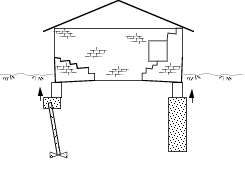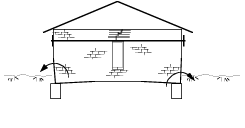REMEDIAL FOUNDATION WORKS— SOLUTIONS TO REACTIVE BUILDING MOVEMENT
Introduction
Regular readers may recall my article of June 2009 on reactive foundation movement, causes and responsibilities. That article was restricted to houses on clay foundations and discussed the activities of the geotechnical consultant, designer, engineer, builder, and owner and how distress may result. The central theme is the prevailing characteristic of clay foundations to shrink when they dry and swell when they get wet and how excessive foundation movement often results from abnormal moisture conditions. This article aims to pick up from the point of diagnosis and outline common remedial solutions.
Site Works and Building Repair
In minor cases remedial works are simply a matter of resolving site maintenance or development issues and repairing the building. If the site factors such as trees and drainage issues are clearly the problem and the building distress has not damaged the structure significantly this is usually sufficient. The extent of movement that leads to readily repairable damage does not usually suggest structural damage to the footings.
Site works are usually a matter of doing everything reasonable to stabilise foundation moisture. This includes checking and repairing plumbing and removing or isolation suspect trees, shrubs and garden beds. Not all home owners want a scorched earth policy in pursuit of building perfection and there often has to be a compromise between vegetation and building performance.
Tree roots commonly reach further than a tree canopy and have the potential to suck moisture from considerably further so trees in public areas and on adjacent sites can be foundation influences. In cases where trees cannot readily be removed an alternative may be the installation of a "root barrier" or, more correctly, a moisture control barrier. The technique is to excavate a narrow, deep trench and install a geotextile or concrete barrier and chemical root inhibitors. Such barriers are not a perfect solution and are subject to physical damage, roots going over or around them and moisture being sucked under them but well designed and maintained barriers can be very effective.
There are other techniques of tree abatement including canopy and root pruning and providing alternative moisture sources.

Resolving site and drainage issues causing foundation moisture fluctuations & repairing the building is a basic first step remedial approach.
If a building has structural cracks from foundation movement it is essential that the cracks be repaired structurally even if the site is fully remedied. Cracks are lines of great weakness and even minor ongoing movement from seasonal foundation fluctuations is often sufficient to reopen them.
A common mistake with old solid masonry houses is to patch the hard plaster internally. As plaster has negligible strength the building simply goes on cracking. Essential procedure is to rake out all cracked mortar courses and re-point full depth or reconstruct cracked areas of brickwork.
This is most important in the case of double masonry construction but even for brick veneer construction it should be done.
Foundation Re-Hydration

Foundation re-hydration can be effective but is most difficult to control.
Other than generally maintaining a site appropriately to stabilise foundation moisture it is possible to locally increase moisture to recover footing settlement. This can be done in a number of ways from redirecting drainage, injecting water at points, drip irrigation etc.
Unfortunately all suffer similar limitations; they are hit and miss unless accompanied by rigourous moisture content monitoring. Unless water is placed exactly where it is required it is difficult to ensure its passage underground and too much moisture can caused disastrous softening.
Then there is the maintenance issue; to be effective moisture contents must be accurately monitored and further water applied exactly as required - for the life of the building. This is not the sort of thing that homeowners are accustomed to doing unless they happen to be highly scientific.
Therefore, for most practical purposes foundation re-hydration is not appropriate but I mention it because it can work and still has some following amongst some experts.
Improving Building Articulation

Well located and detailed control joints can take up minor movements without distress.
Clad framed buildings can usually sustain substantial foundation movement with minimal cracking that can be treated as cosmetic. Similar movement often causes cracking in solid masonry or masonry veneer buildings but it is surprising how much movement such buildings can sustain with appropriate articulation.
Modern buildings of this type benefit from control jointing of masonry that provides for some movement at the joints without distress. Although control jointing of commercial buildings has been around since the 1960s amazingly brick veneer houses were not routinely control jointed until the 1980s. Thus older masonry or masonry veneer buildings can sometimes benefit from the addition of control joints. This is only a symptomatic treatment of course and does nothing to abate foundation movement but such treatment can be important if the owner wants to retain trees, for instance.
Placement and detailing of additional control joints requires careful consideration. In the case of double masonry it is often impossible to avoid exposing joints internally; if they can't be hidden behind joinery it may be better to accept occasional plaster cracking and repair internally.
Grout Injection

Grout injection has some specialised applications but is not a replacement for deep underpinning.
Considerable progress has been made in recent decades in the techniques of grout injection to fill voids and in some cases raise structures. The basic technique is to pump a chemical into below ground voids that expands as it cures. For this to be effective there must be voids to pump into and the cavity must contain the grout so that expansion raises the slab or footing rather than bursting out elsewhere. These are pretty specialised conditions that generally only occur under slabs with well contained edges.
While claims have been made that such techniques can be effective in other conditions including under strip footings this is not well accepted.
There are other problems and limitations not the least of which is that this technique does not address any ongoing foundation influences and may event exacerbate heave. In the reactive foundation condition we are discussing here it would therefore only be applicable to long term settlement caused by drying to an equilibrium state as commonly occurs under the centre of buildings.
There are other issues with specifying such works in the context of the resolution of a building dispute; there is no way to ensure they will work or even to reliably define the scope of works; not an easy one to negotiate!
Grout injection seems destined to remain a specialised technique for specific applications.
Underpinning

Underpinning by bulk pads or screw piles can be effective but must be carefully engineered.
The most commonly known solution is the process of underpinning which in simple terms involves placing a deeper footing under an existing footing. This achieves a locally deeper foundation which is likely to be more stable and can provide a platform off which the existing footing can be jacked back into place.
Comprehensive underpinning is the ultimate solution to improve a building's resistance to reactive foundation conditions but there are problems: It is rarely cost effective or necessary to underpin the entire footing system thus we are left with part of the building on a deep underpinned foundation and part of it on the original foundation. This can give rise to differential movement between the underpinning and non underpinned parts of the building and resultant distress.
A major mechanism of reactive movement is footing rotation as opposed to settlement or heave and underpinning does little to address this. Underpinning is notoriously expensive and difficult being labour intensive and invariably involving work in confined spaces. Walls on boundaries and internal walls can present great difficulties.
There are many differing underpinning techniques but the two most common in Melbourne are bulk pads and screw piers. Bulk pads are simply lumps of concrete poured under existing footings. Screw piers are steel screw in footings that are inserted obliquely beside footings to base on the foundation under; a reinforced concrete cap is then poured to link the two. Screw pier underpinning is particularly suitable when a very deep underpin is required such as the worst cases in Elwood.
Structural Ties & Masonry Reinforcing

Steel ties and local masonry reinforcement can improve resitance to rotation.
There are a range of techniques available to reinforce masonry structures to improve resistance to foundation movement. Most of these relate to reducing rotation rather than settlement affects.
Effective repair of cracked masonry is the first, better than this masonry can be reinforced locally by fitting light metal in the masonry courses. Proprietary stainless steel products are available that are effective at improving week points such as small brick panels over windows where cracking tends to result from adjacent walls rotating outward.
Steel ties right through the building fixed to plates outside are a good solution for free standing masonry buildings and are often used in restoration work to strengthen old brick or stone buildings. If access is good such works are comparatively low cost. The limitation is that improving masonry by any means does not reduce foundation movement; if movement continues ties or reinforcement can simply pull that section of wall out. Therefore masonry reinforcing should generally be used in conjunction with abatement of foundation influences.
In the context of a building dispute where resolution involves restoring an ideal situation with a modern building site works and building repair and underpinning are the most common responses. Most of the other techniques discussed are more often employed in conservation works or where a degree of compromise from the technical ideal is implicit in the settlement terms.
